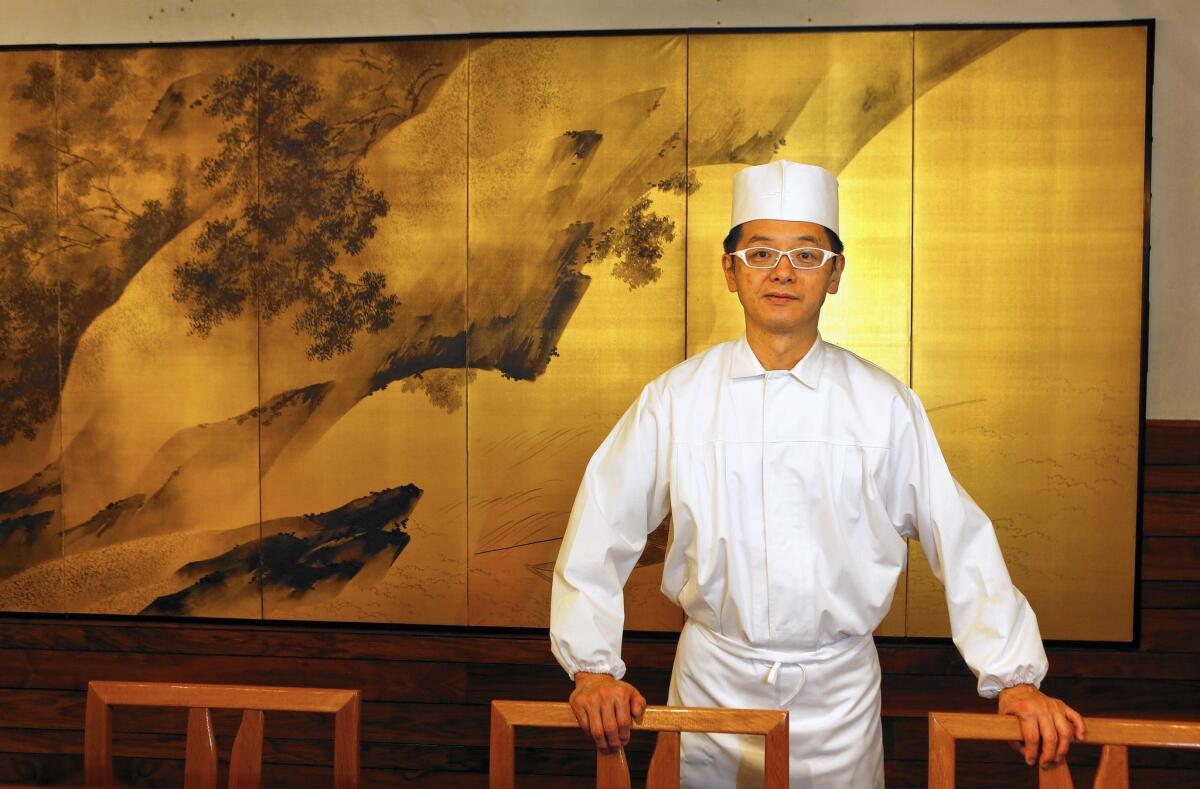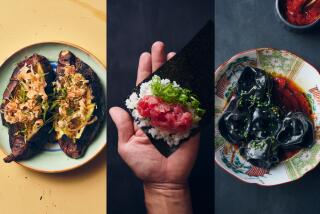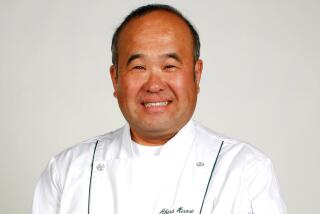Step back in time at Q, dedicated to the craft of Edo-style sushi

Finding chef Hiroyuki Naruke is a treasure hunt. You’re in downtown Los Angeles. You battle through the chaos of 7th Street’s battery of restaurants. You push open a heavy wooden door marked only by the letter Q, as if you’re entering a Freemason’s lodge or a 19th century guildhall.
Inside is what amounts to a wrinkle in time and place, a restaurant dedicated to the vanishing craft of Edo-style sushi. Originally made only from the fish that came from Tokyo’s Edo Bay, Edomae sushi began as a 19th century street food engineered from cured fish and palliative accompaniments because of the lack of refrigeration.
Here in Los Angeles, however, even in the city that popularized sushi in America, Edo-sushi is the very opposite of street food. It’s as rare as condors. Q is less a restaurant than a museum funded by an eccentric band of downtown lawyers with Naruke as caretaker.
SIGN UP for Jonathan Gold’s Counter Intelligence dining newsletter >>
Here in Naruke’s world, his beautiful counter was custom built from walnut, and a wood-paneled ceiling curves like a Viking ship. And there are only 26 seats for customers willing to submit to his choice, and his choice only, of an omakase menu.
Naruke, 51, is slight and conspicuously bespectacled — his white glasses are fantastic, as if Warby Parker had invented pairs for chefs.
Behind him are displayed a 1,500-year-old sake pot, a vertical wall of abacuses and various objets d’art befitting a place walking distance from Little Tokyo. Behind the diners at the sushi bar is a Japanese print the size of a billboard that dates to the 1700s.
The veneer of antiquity is accidental. Naruke had been working at a six-seat Tokyo sushi bar when a regular customer, a lawyer from Los Angeles, persuaded him to consider relocating. In the aftermath of the Fukushima disaster, that wasn’t a hard sell. The lawyer, Ryan Goldstein, worked at the firm of Quinn Emanuel Urquhart & Sullivan. After he and fellow lawyers Shon Morgan and John B. Quinn opened the restaurant, it gained the initial Q for Quinn.
The partnership functions simultaneously as owners, patrons, curators of the museum and permanently hungry fan club.
In clear but limited English, Naruke will tell you that before he was lured to skipping distance of the Quinn Emanuel offices, he apprenticed at a Tokyo sushi bar at the age of 18, then, after a series of jobs, began working in kaiseki restaurants. Kaiseki, another centuries-old culinary genre, is considered Japan’s haute cuisine.
At Q, you can find this kaiseki influence in the tiny bowl of uni misosuke, served mid-course — sea urchin that has been marinated in sweet miso for more than a month. “You won’t find this in other sushi restaurants,” Naruke says, as if he’s told you a secret.
From Naruke’s counter also come small pieces of nigiri sushi, the fish lightly cured, perfectly cut, then pressed exactly onto a bed of rice (red vinegar, Japanese rice, sea salt, no sugar). If wasabi is appropriate, then it’s freshly grated and applied according to the demands of the fish. If soy sauce or other sauce, then it too is house-made or house-blended, brushed like paint and again deployed according to the seafood. The ginger is pickled in-house, cut thickly then stacked like tiny decks of cards on each plate.
“Talking to customers is a sushi chef’s duty,” he says, and you wonder if his reticence is a function of culture, generation, language or just the business of the restaurant on an unreasonably hot October afternoon.
Naruke’s quiet performance can seem solitary. Not quite, though. Because while he is braiding needlefish into silver ribbons for you, Ruiz Mateo is in the kitchen preparing the sea eel for peeling, nailing their heads to the cutting board with an awl like an ice pick.
Mateo, a Peruvian Japanese Angeleno who trained in Japan for 20 years and worked in high-profile L.A. sushi restaurants, manages a series of bowls filled with small schools of perfect fish kept cool in ice water baths.
It all ends when the woman in the black sheath dress, who turns out to be Naruke’s wife, Kyoko, brings you both tea and the bill. At what price, tradition? The bill — omakase dinners start at $165 per person — may limit the audience for Edomae sushi to lawyers earning $700 an hour.
Such is the price of what used to be street food, in which a hundred kohada, tiny gizzard shad, have been cut by hand in the kitchen every day and a single tray of the tamago, a cube of which ends each meal at Q, takes three slow hours to make.
But there are moments when the chef smiles, maybe less at you than at his knives (there are always knives in the conversation at sushi bars), and considers his situation: traveling between the small islands of his counter and the spare, immaculate kitchen connected to it, making antique albeit perfect food across the street from Bottega Louie.
He considers the kohada again, perhaps the most fundamental fish in Edomae sushi, and one that can take years for chefs to master. “It’s our French omelet,” he says.
It’s a vanishingly rare thing, this food, built into a museum for the 1%, that you may never be able to afford.
But it is also a beautiful time machine, one you can climb inside, sit down in and have the most astonishing dinner.
More to Read
Eat your way across L.A.
Get our weekly Tasting Notes newsletter for reviews, news and more.
You may occasionally receive promotional content from the Los Angeles Times.











